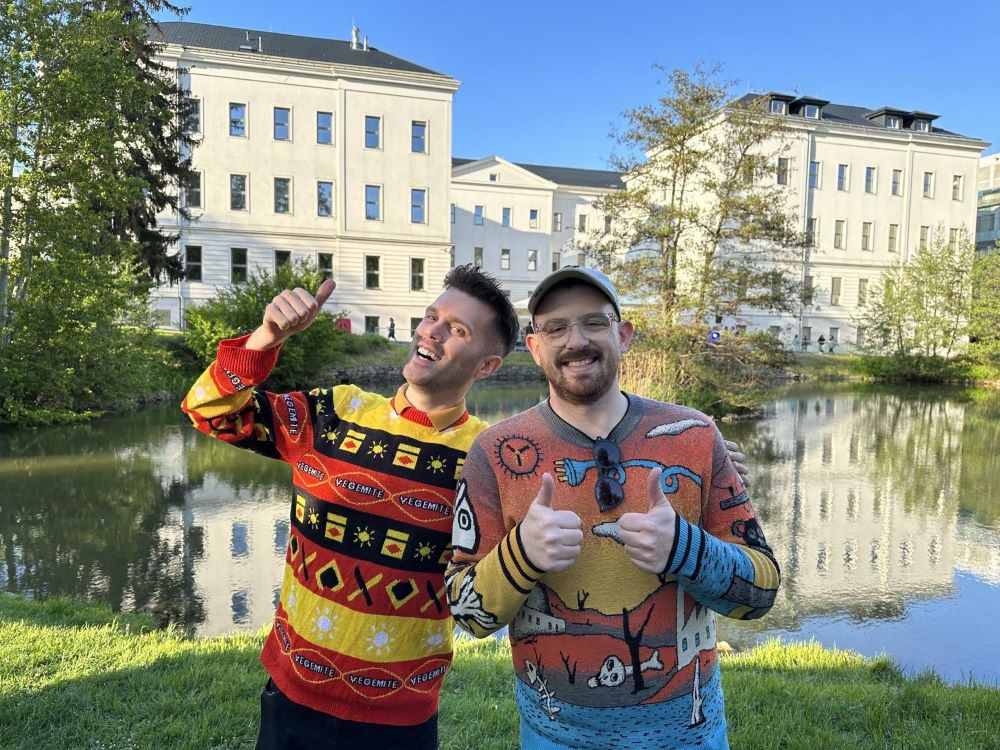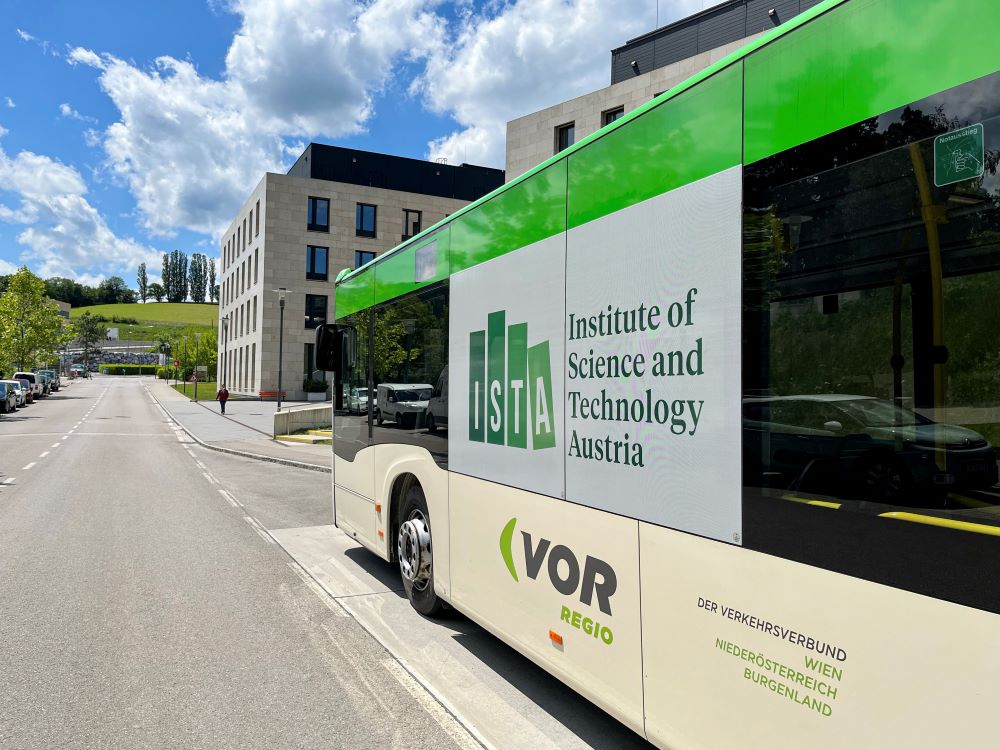August 10, 2023
Revelations on the 142
ISTA's first journalist in residence recaps his time on campus
With its new residency program, the Institute of Science and Technology Austria (ISTA) provides talented science journalists with resources and access to scientists doing frontier research. Longform reporter Jackson W. Ryan was among the first journalists to join the campus community for several months in spring. Now, he looks back on an inspiring time full of exciting science stories.

By the time the ISTA shuttle bus, number 142, rolls into its first and only stop at Klosterneuburg, I am usually asleep. At the very least, my head is drooping this way and that way as I fight to keep my eyes focused on whatever scene flies past the window. When I see the giant yellow chicken that sits out the right hand side of the bus, just past “Klo’burg”, with BACKHENDL scribbled on its chest, I know I’ve reached a significant waypoint. That’s when I know I’ll make it to ISTA having won the battle against Big Snooze.
The shuttle, that green-and-white box that shuffles scientists and researchers from Vienna to the ISTA campus, is one of the enduring memories from my time as the first science journalist in residence at ISTA. There are two reasons it lingers: Of course, I spent a lot of time on the shuttle bus. That’s one. But the second, more important reason is that whenever I could stave off sleep, whether heading to ISTA or back home, bus number 142 provided a lot of time to think.
And there’s a lot to think about right now, as a science journalist.
This is a very interesting time for digital media and science journalism. The trust in experts — scientists, researchers, basically anyone with a degree — is faltering. In some places, it’s sputtered to a standstill and even reversed. In real-time, on Twitter feeds, on TV news, you can see the many different realities forming. The multiverse isn’t some confusing Science Fiction concept that brings Marvel superheroes back from the dead. It’s the world we live in, particularly when we engage with each other online.
Awe-inspiring science stories
There are places where conspiracies run rampant, immune to truth or fact. There are universes where misinformation circles the globe before truth has even had time to put its shoes on. There are fewer locales, websites and publications, it seems, where the truth truly makes an impact. It’s difficult to know which multiverse will ultimately win out, especially with the rise of artificial intelligence that can generate confident-sounding sentences on the fly or paint a scene around the Mona Lisa in seconds.
For those that didn’t get a chance to interact with me during my residency, I’m a major advocate of longform, narrative-focused science writing. I’m a really big fan of storytelling as a powerful tool to get science into the public consciousness and keep it there. I know scientists love data (I was one, once) and I’ve got that, I swear — nevertheless, I’ve seen the impact a carefully crafted story can make. I’ve seen how presenting awe-inspiring stories and delivering answers to the world’s most pressing questions really galvanizes support for science and tech. This sounds twee but… it can change the world, you know?
And so, on the ISTA shuttle bus, I often thought about how the stories at ISTA might just change the world. What I learnt in my three months as science journalist in residence is that, unequivocally, there are stories here. Incredible stories. Stories that extend far beyond the bounds of a single study published in a prestigious journal once every few years. Stories that highlight the scientific process, the collaborative spirit of the Institute and the people who make the advances that rewrite our understanding of the world.

Hunting scorpionflies and tipping over stones
Early on, I sat with Krzysztof Pietrzak as he regaled me with research and insight about blockchains and “proof of space.” Christoph Lampert and I discussed the oncoming AI Not-pocalypse over a cup of coffee in the Error Bar, a conversation I still think about to this day and one that has only become more relevant in the months since. When I sat down with Lisa Bugnet to learn about the magnetic fields inside giant stars, my brain exploded — not just from the bonkers work she’d done to understand them but from the amount of story ideas the talk generated.
Then there was the afternoon where, with the sun beating down on our backs, I watched on as Michaela Hönigsberger and Florian Strahodinsky tipped over stones in an ISTA garden and, with joyous shouts, pointed out the larvae of ant colonies, scooping them up with plastic spoons and dropping them into petri dishes.
On another, I walked with researcher Clementine Lasne beyond the boundaries of the Institute and into the grassy fields lurking just out of sight. We were hunting scorpionflies and, with net in hand, Clementine scoured the side of the road for a thumbnail-sized insect that I had never even heard of before meeting her. Within a few minutes, she’d swiped at a patch of greenery and imprisoned our target in a test tube. Clem, though, failed to tell me about the ticks that could have crawled into my clothing until later that evening, leading to a frantic interrogation of every inch of skin. Encephalitis, she mentioned, was something I probably wasn’t vaccinated against so I needed to be thorough. She was right and, in the process, scared the absolute heck out of me.
The time for good stories is now
This is just a snapshot of the kinds of stories that exist inside — and outside — the walls of ISTA. ISTA has the ability to be a story machine. It has the opportunity, as a young institute with talented, enthusiastic, hard-working, extremely skilled scientists, to redefine science storytelling not just in Austria, but across the globe. For me, there was nothing more valuable than spending time with the scientists and researchers in the labs, out in the field, at a desk or over coffee. This is both a thank you note and a plea: We need more of this.
In autumn, ISTA will open up the science journalism residency for a second time. A new face will appear sometime in 2024. I’d implore the scientists, researchers, and staff at ISTA to invite them into your lab or across to the Error Bar. Grab a laugenstangerl at Billa, if you have to. Show them the cool things you can do just outside the grounds of the Institute or by tipping rocks just behind the Bertalanffy Foundation Building. Explain to them how to make AI more ethical, what the hell is going on inside Red Giants and how to make blockchain better. Tell your stories. We need them right now.
The very last time I jumped on the shuttle bus, on May 23, I was reading a story about whale magnetoreception — the way they use the Earth’s magnetic fields to navigate. Scientists aren’t sure how or why just yet. It was enthralling. I was captivated. I made it from the ISTA campus all the way to Vienna without dozing off once.
That’s the power of a good story. I hope you will tell yours.
Jackson W. Ryan was the first science journalist in residence at ISTA. He visited from February to May 2023. You can contact Jackson at his website and read his writing here.



